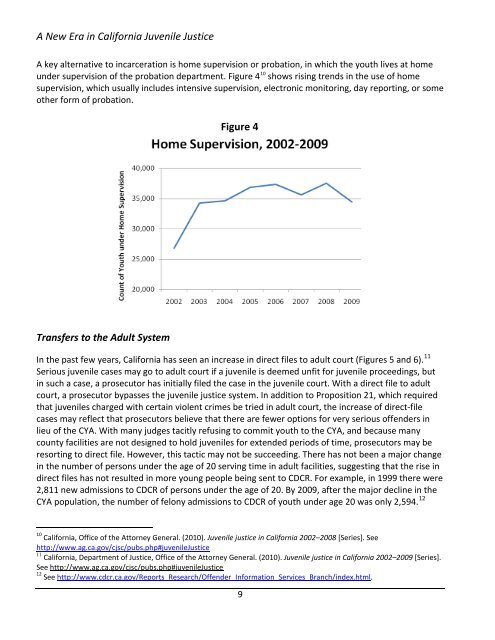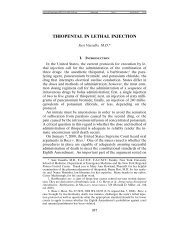October 2010 Barry Krisberg, Ph.D. Linh Vuong Christopher Hartney ...
October 2010 Barry Krisberg, Ph.D. Linh Vuong Christopher Hartney ...
October 2010 Barry Krisberg, Ph.D. Linh Vuong Christopher Hartney ...
Create successful ePaper yourself
Turn your PDF publications into a flip-book with our unique Google optimized e-Paper software.
A New Era in California Juvenile Justice<br />
A key alternative to incarceration is home supervision or probation, in which the youth lives at home<br />
under supervision of the probation department. Figure 4 10 shows rising trends in the use of home<br />
supervision, which usually includes intensive supervision, electronic monitoring, day reporting, or some<br />
other form of probation.<br />
Transfers to the Adult System<br />
Figure 4<br />
In the past few years, California has seen an increase in direct files to adult court (Figures 5 and 6). 11<br />
Serious juvenile cases may go to adult court if a juvenile is deemed unfit for juvenile proceedings, but<br />
in such a case, a prosecutor has initially filed the case in the juvenile court. With a direct file to adult<br />
court, a prosecutor bypasses the juvenile justice system. In addition to Proposition 21, which required<br />
that juveniles charged with certain violent crimes be tried in adult court, the increase of direct-file<br />
cases may reflect that prosecutors believe that there are fewer options for very serious offenders in<br />
lieu of the CYA. With many judges tacitly refusing to commit youth to the CYA, and because many<br />
county facilities are not designed to hold juveniles for extended periods of time, prosecutors may be<br />
resorting to direct file. However, this tactic may not be succeeding. There has not been a major change<br />
in the number of persons under the age of 20 serving time in adult facilities, suggesting that the rise in<br />
direct files has not resulted in more young people being sent to CDCR. For example, in 1999 there were<br />
2,811 new admissions to CDCR of persons under the age of 20. By 2009, after the major decline in the<br />
CYA population, the number of felony admissions to CDCR of youth under age 20 was only 2,594. 12<br />
10<br />
California, Office of the Attorney General. (<strong>2010</strong>). Juvenile justice in California 2002–2008 [Series]. See<br />
http://www.ag.ca.gov/cjsc/pubs.php#juvenileJustice<br />
11<br />
California, Department of Justice, Office of the Attorney General. (<strong>2010</strong>). Juvenile justice in California 2002–2009 [Series].<br />
See http://www.ag.ca.gov/cjsc/pubs.php#juvenileJustice<br />
12<br />
See http://www.cdcr.ca.gov/Reports_Research/Offender_Information_Services_Branch/index.html.<br />
9

















